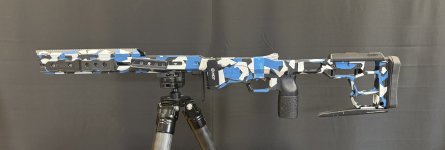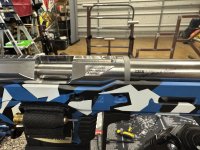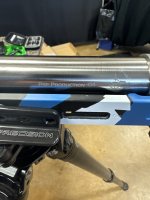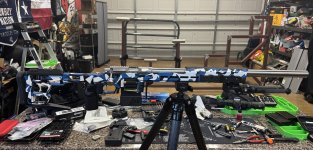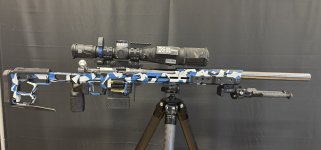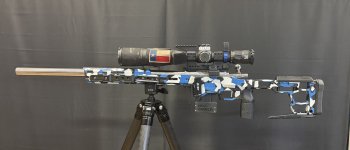Join the Hide community
Get access to live stream, lessons, the post exchange, and chat with other snipers.
Register
Download Gravity Ballistics
Get help to accurately calculate and scope your sniper rifle using real shooting data.

Install the app
How to install the app on iOS
Follow along with the video below to see how to install our site as a web app on your home screen.
Note: This feature may not be available in some browsers.
You are using an out of date browser. It may not display this or other websites correctly.
You should upgrade or use an alternative browser.
You should upgrade or use an alternative browser.
Desert Precision Gunworks 22LR Action Updates
- Thread starter J_D
- Start date
In PRS/NRL when you are transitioning to another position/prop it keeps the bolt from falling forward and causing a feeding malfuction.What is the benefit?
Pretty genius idea.
My T1x will malfunction, my B14-R will actually chamber a round...In PRS/NRL when you are transitioning to another position/prop it keeps the bolt from falling forward and causing a feeding malfuction.
Pretty genius idea.
Heard about a “notify me” link.
Where is that found?
I don't know that I've ever seen anyone transition a PRS/NRL stage with the rifle pointed at the ground.
In fact, most match directors want everyone to transition with the rifle facing up.
Do you really want to get technical? Have you ever gone from the top of a cattle gate to the bottom of one? Have you ever gone from a high to very low position?I don't know that I've ever seen anyone transition a PRS/NRL stage with the rifle pointed at the ground.
In fact, most match directors want everyone to transition with the rifle facing up.
Just tilting my RimX caused problems. Some guys literally have rubber bands holding the bolt back. You can always use a Vudoo or RimX if you don’t like a feature. Even holding the rifle pointing to the sky, you reach a point so low it is going to be downwards to get that low.
I rather like it, and specifically asked for it to test.
Last edited:
Throwing a rifle up on a prop and/or barricade easily generates enough force to run a smooth bolt forward. I guarantee you can go to any match and someone will point a rifle at a downward angle at some point. It's not exactly easy to throw around a 20 lb+ rifle for a couple hours.I don't know that I've ever seen anyone transition a PRS/NRL stage with the rifle pointed at the ground.
In fact, most match directors want everyone to transition with the rifle facing up.
I believe he said the feature is removable.I don't know that I've ever seen anyone transition a PRS/NRL stage with the rifle pointed at the ground.
In fact, most match directors want everyone to transition with the rifle facing up.
Correct.I believe he said the feature is removable.
Have it and not needed it? Feature can be removed/ disabled. The detent is also how I keep the bolt from over caming to the opposite side.
The downside of having an extremely smooth bolt, which I found out last weekend at a monthly NRL22 match with this action is that itll bump the bolt forward during fast transitions. Happened on the ladder stage "home improvement". I tend to tilt the rifle sideways when entering port holes or small spaces and slide the rifle up to a smedium. If done fast enough, I've jamed a Rim-X and Vudoo quite often this way
I was recently contemplating how to retrofit something like this or a rare earth magnet to the rear action screw.Correct.
Have it and not needed it? Feature can be removed/ disabled.
The downside of having an extremely smooth bolt, which I found out last weekend at a monthly NRL22 match with this action is that itll bump the bolt forward during fast transitions. Happened on the ladder stage "home improvement". I tend to tilt the rifle sideways when entering port holes or small spaces and slide the rifle up to a smedium. If done fast enough, I've jamed a Rim-X and Vudoo quite often this way
their is a unique feature on the bottom of the action if you look at post #147 that will allow a single shot adapter to fill the magwell port of the action. Also CZ457, T1X and Anchutz guys might benefit from it in the future "winky winky"Need a single shot version for f class
Provisional patent filed
Do you really want to get technical? Have you ever gone from the top of a cattle gate to the bottom of one? Have you ever gone from a high to very low position?
Just tilting my RimX caused problems. Some guys literally have rubber bands holding the bolt back. You can always use a Vudoo or RimX if you don’t like a feature. Even holding the rifle pointing to the sky, you reach a point so low it is going to be downwards to get that low.
I rather like it, and specifically asked for it to test.
Happened to me when nesting the rifle into the bag and bumping the barricade stop…. U know, an object in motion stays in motion etc etc.. it’s just enough to strip a round.
Didn’t realize what I was doing until someone pointed it out.
Just got my first batch of dual spring rate extractor springs and tested them this whole afternoon 500+ rounds. These will interchange with Gen 2 and 3 V22s also. It increases the extractor spring pressure while maintaining the same spring rate to control round feed reliable from the mag. Also found best angle cuts for my S7 extractors for this action. Very minimal force needed to send cases flying

Another great video to add to the scrapbook for the birth of the DPG barreled action!
How sensitive is the controlled feed system to magazine/cartridge alignment? Can you have much magazine “slop” and the bolt/extractor/holder will be consistent in picking up and holding correct alignment to feed into the chamber?
How sensitive is the controlled feed system to magazine/cartridge alignment? Can you have much magazine “slop” and the bolt/extractor/holder will be consistent in picking up and holding correct alignment to feed into the chamber?
To not give to much away, that's kinda the idea to the bottom feature I added and eluded to earlier. It tightens up a lot of that play. I'll demo it and explain to those who attend gravestone match and have a video of it once I get the first patent claims approved. Basically side loading and preloading doesn't effect its reliability regardless of chassis/stock or bottom metal from my testing so far.Another great video to add to the scrapbook for the birth of the DPG barreled action!
How sensitive is the controlled feed system to magazine/cartridge alignment? Can you have much magazine “slop” and the bolt/extractor/holder will be consistent in picking up and holding correct alignment to feed into the chamber?
I have new V22 mags I tried to today to seek mag options when these launch. 3 out of the 5 kept nose upping 2nd to last round. Measurements are all over the place with these "new" mags at the feed lips. So im going to pass on using V22 mags as what is to be included. Rim-X mags are hard to come by and I've had mix results with L3i mags. Haven't tried their metal ones yet. Pretty much stuck with just moving forward to make my own mag at this point.
Since it uses Mike Bushes extractor design and bolt head, it actually picks up and puts a round into the extractors without a barrel. As im understanding more, single stack mags allow for just one axial force vs a slant fed mag needing a heavier spring to over come two forces to allow rounds to feed into the extractor
Like how trigger pin recess is opened up a bit. Are they an interference fit or is there some sort of keeper / threading involved? Must admit changing a trigger in the field on my Vudoo is a nightmare...
Damn brilliant idea that addresses a real world problem, this is shaping up to be a cutting edge action...keep up the good work Kenny !
Just in case anyone missed it, DPG is an official commercial supporter
Last week and the last few days of May was all dedicated to fine tuning and refinement. With 5 actions barreled and tested (15 action body attempts and refinement lol), I used the time to test a few different bolt geometrys and sacrificed one action to a hydraulic shear test, corrosive and brute force test on the heat treated parts. The 2 bolt stops tested at 1680 lbs and 1890 lbs axial force to shear the bolt stop from pressure exerted on the bolt face. 17-4 ph bare metal action held up to a salt bath mist for 5 days with minor galvanic corrosion and not hard lock up.
Its been some long 20+ hr days that was originally alloted for my clients who had Rim-X builds. I wanted to fulfill my promise to them and Im still ahead of schedule for release, but this project will have to continue in July as I need to fulfill my other client builds.
Im not a big fan of 3D printed parts on a proposed premium action, however, the technology still allows for a few items like a bolt dissembly tool with spare set screws, ball detents and springs to give a cool addition to the tool bag. Along with a cool feature on this action which ill mention in detail after June 14th.

Since this action is using the V22 firing pin assembly, I thought I'd pay homage in making a similar bolt dissembly tool that fits the rear cap of this action. I also made what im going to call the Facet Spool and Facet Spool XL bolt handle and the traditional tear drop. I would like to hear feedback one what handles you guys prefer? These handles are made from 416 stainless and give a premium feel in weight. 7075-T6 aluminum had a brighter shine that was noticeable when nitrided to those who have a keen eye. Keeping the handles in the stainless category will aid in uniformity with DLC / nitride processes and IMO, gives a more premium feel
The first barreled action was sent out to one of our selected pro shooters for evaluation. The other 4 are still at DLC/ Nitride facilities. These actions also will be sporting a new barrel and rifling design that I hand tapper lapped myself. Testing so far even at this barrel length of 26in produced 1050-1075 FPS, zero cold bore shift and just flat out hammered consistly in the low 0.2's at 50 yards and near 0.5 at 100 yards. No need to charge, take advantage of the client and install some phallic looking muzzle devices that some sell and claim "tune" ammo on these heavy 1.20 barrels. Until some proven data that those devices work with these types of barrels, ill lean on the resonance harmonic testing performed by balasticians in lab environments, downrange results and statistics speak for themselves. Not saying Tuners do not work, they do not work with these heavy barrels and chamber sacrifices have to made to allow reliability in a repeater action. The point in PRS is to eliminate variables, not add any and give doubt your rifle didnt perform because of a tune setting. AND theirs better ways to tune a 22lr rifle E.G. firing pin timing, spring rate, headspace are some way noticeable differences which are often overlooked. Your firing pin spring makes a huge difference and many forget to replace it over time. These barrels have a lower chromium and higher molybdenum content to help deaden the "ring" and allow for more lots of ammo to perform at match level. Ill have more collective testing done after sorting/building and testing these 375 barrels and post a separate thread on my barrel development journey. Im also testing some new Criterion 22lr barrels and seen some amazing results with this action.

Im excited to the upcoming debut at the Best of the West 22lr Match at Gravestone coming June 14th. Many shooters across the world will be there and I've been flooded with emails and questions about this project. Even had offers to sell the license to manufacturer. Which though was tempting, I have a different goal in mind.
I want to see this project through as I aimmed to give our community a great option for a competition based 22lr action. Where this market has been cornered with limited choices and manufacture defects. Our shops past expirence was a wake up call and push to provide options. To also make a stand on not accepting poor quality! And showcase what small USA manufacturing with 100% in house development, designing, machining and manufacturing can once again provide. Like the good old days when one can claim handcrafted not assembled. Its "Back To The Beginning"... Let's go!!!
-Ken
Its been some long 20+ hr days that was originally alloted for my clients who had Rim-X builds. I wanted to fulfill my promise to them and Im still ahead of schedule for release, but this project will have to continue in July as I need to fulfill my other client builds.
Im not a big fan of 3D printed parts on a proposed premium action, however, the technology still allows for a few items like a bolt dissembly tool with spare set screws, ball detents and springs to give a cool addition to the tool bag. Along with a cool feature on this action which ill mention in detail after June 14th.
Since this action is using the V22 firing pin assembly, I thought I'd pay homage in making a similar bolt dissembly tool that fits the rear cap of this action. I also made what im going to call the Facet Spool and Facet Spool XL bolt handle and the traditional tear drop. I would like to hear feedback one what handles you guys prefer? These handles are made from 416 stainless and give a premium feel in weight. 7075-T6 aluminum had a brighter shine that was noticeable when nitrided to those who have a keen eye. Keeping the handles in the stainless category will aid in uniformity with DLC / nitride processes and IMO, gives a more premium feel
The first barreled action was sent out to one of our selected pro shooters for evaluation. The other 4 are still at DLC/ Nitride facilities. These actions also will be sporting a new barrel and rifling design that I hand tapper lapped myself. Testing so far even at this barrel length of 26in produced 1050-1075 FPS, zero cold bore shift and just flat out hammered consistly in the low 0.2's at 50 yards and near 0.5 at 100 yards. No need to charge, take advantage of the client and install some phallic looking muzzle devices that some sell and claim "tune" ammo on these heavy 1.20 barrels. Until some proven data that those devices work with these types of barrels, ill lean on the resonance harmonic testing performed by balasticians in lab environments, downrange results and statistics speak for themselves. Not saying Tuners do not work, they do not work with these heavy barrels and chamber sacrifices have to made to allow reliability in a repeater action. The point in PRS is to eliminate variables, not add any and give doubt your rifle didnt perform because of a tune setting. AND theirs better ways to tune a 22lr rifle E.G. firing pin timing, spring rate, headspace are some way noticeable differences which are often overlooked. Your firing pin spring makes a huge difference and many forget to replace it over time. These barrels have a lower chromium and higher molybdenum content to help deaden the "ring" and allow for more lots of ammo to perform at match level. Ill have more collective testing done after sorting/building and testing these 375 barrels and post a separate thread on my barrel development journey. Im also testing some new Criterion 22lr barrels and seen some amazing results with this action.
Im excited to the upcoming debut at the Best of the West 22lr Match at Gravestone coming June 14th. Many shooters across the world will be there and I've been flooded with emails and questions about this project. Even had offers to sell the license to manufacturer. Which though was tempting, I have a different goal in mind.
I want to see this project through as I aimmed to give our community a great option for a competition based 22lr action. Where this market has been cornered with limited choices and manufacture defects. Our shops past expirence was a wake up call and push to provide options. To also make a stand on not accepting poor quality! And showcase what small USA manufacturing with 100% in house development, designing, machining and manufacturing can once again provide. Like the good old days when one can claim handcrafted not assembled. Its "Back To The Beginning"... Let's go!!!
-Ken
Last edited:
Are the Facet Spool and Facet Spool XL comparable in size to your Rivalry and XL versions you make for the CZ? Hard to tell in these photo the overall size.
Would you consider selling an entire set so the user can choose or swap as they want?
Love the look of the bolt handles and how they all look coming together!
Would you consider selling an entire set so the user can choose or swap as they want?
Love the look of the bolt handles and how they all look coming together!
@EagleEyeShooting Kenny I personally prefer the non barbell bolt handle, so the taller one of the two you have standing on end.
That actually sounds like a good idea. Maybe I'll have the option to choose your top 3? I'll have the traditional ball added also. The XL is the same size as the Rivalry XL and the small Facet is slightly smaller than the Original Rivalry.Are the Facet Spool and Facet Spool XL comparable in size to your Rivalry and XL versions you make for the CZ? Hard to tell in these photo the overall size.
Would you consider selling an entire set so the user can choose or swap as they want?
Love the look of the bolt handles and how they all look coming together!
Until I get my 9 axis CNC delivered, I won't be able to make handles that are swept. But it's coming
That would be awesome! Thanks for the quick update. And I thought I start my day early and I am in NH!That actually sounds like a good idea. Maybe I'll have the option to choose your top 3? I'll have the traditional ball added also. The XL is the same size as the Rivalry XL and the small Facet is slightly smaller than the Original Rivalry.
I personally love the Big Bertha knob from Anarchy Outdoors. The geometry hits a sweet spot of comfort and repeatability: the knurling doesn’t create high points, the edges are soft, and the radius cut between the knurled surfaces is perfectly placed for the side of my finger to index in it when I run the bolt (I use the method of placing my thumb on top of the chassis and sweeping all of my fingers up under the bolt handle, using the thumb as leverage).
Bolt handles are like assholes. I run steel Area 419 knobs on all my rifles with standard thread pitch bolt handles and bought 419 adapters to run on Big Horn and Defiance actions when I had those.
And I thought I start my day early and I am in NH!
Yesterday never ended…
Fair point. Best just to make a bolt handle that can accommodate common 3rd party thread patterns for knobs.Bolt handles are like assholes. I run steel Area 419 knobs on all my rifles with standard thread pitch bolt handles and bought 419 adapters to run on Big Horn and Defiance actions when I had those.
I originally designed the bolt assembly in mind to use the Anarchy Outdoors B14r bolt handle and bolt knobs until those prices went up. This can easily be implemented to the shooter by removing the M6x1 allen set screw and replaced with the Anarchy bolt knob assembly.Fair point. Best just to make a bolt handle that can accommodate common 3rd party thread patterns for knobs.
Will you also be making a single shot benchrest version, left and right ports?It works with medium and high. Haven't tried a low but my Flavio 0.5oz BR trigger works which says it shouldn't have an issue.
Thanks!
Going the other direction, can your bolt knobs be used on a B-14R? That'd be cool, there are so few options for Bergaras and they all kinda suck.I originally designed the bolt assembly in mind to use the Anarchy Outdoors B14r bolt handle and bolt knobs until those prices went up. This can easily be implemented to the shooter by removing the M6x1 allen set screw and replaced with the Anarchy bolt knob assembly.
Just reading the description of the testing, it’s not hard to see why a custom action is a pricy action. Lot more to it than jsut cranking up the ole CAM machine and letting it grind away at a block of steel.
Exactly. Thiers ways obviously to lower cost, but let's be honest. If a manufacturer can find a way to reduce machine time or manufacturer cost, they would make higher margins, hence why material changes occur and quality issues happen when those changes aren't throughly tested. Of course availability is always a factor, however, thier are so many options in the same steel category that are plentiful instock. I know this because I deal with steel suppliers on a daily. So unless your dealing with super metals, availability isnt a factor for a significant material change. Reducing MSRP is last on the list with bigger buisness needing to uphold shop cost. Material changes occur mostly to reduce machine time and tool wear to meet tolerances and product demandJust reading the description of the testing, it’s not hard to see why a custom action is a pricy action. Lot more to it than jsut cranking up the ole CAM machine and letting it grind away at a block of steel.
To do this right, requires no sacrifice in the material. This will lead to higher tool wear and replacement to meet tolerances and obviously reflect the cost of the action. But if the consumer is going to pay 1,200+ for a premium action. It better start with quality material. Its a win win for both the manufacturer and consumer if the manufacturer invest in tooling and machinery that
1.) Can uphold the tolerances and reduce machine time
2.) Constantly innovate to put better quality or products
3.) A good machinist and programmer that knows how to operate tooling at its peak efficiency and tool paths
These CNC's that are capable of holding this kind of quality, tolerance and production rate start at 300K. Its big investment but is what sets gun builders apart. A balance of quality and production. Fortunately, I was raised to live by FTQ (First time quality)
Last edited:
Going the other direction, can your bolt knobs be used on a B-14R? That'd be cool, there are so few options for Bergaras and they all kinda suck.
These knobs appear to work with the B14r also if I install the M6x1 grub screw. Anarchy unfortunately converts the thread with thier handle to a 5/16, meaning you will need a 5/16x24 knob. CZ457 and B14rs using M6x1
LikeReady to send rounds down range.
DislikeLot testing begins Sat.
@EagleEyeShooting what are your thoughts of barrels and lot sensitivity?
Have you found a particular barrel twist, rifling, chamber, etc is more or less sensitive to batches/lots or is there no effect?
I'm about 90% on board with longer barrel=lower SD, but as most people are doing 24+" for balance these days it's kind of a moot point.
Or are you seeing a difference between 24", 25", 26"?
Damn you. I’m so jealousReady to send rounds down range. Lot testing begins Sat.
Balanced perfectly.
View attachment 8702905View attachment 8702906
I was told this barrel was not picky from various lots including some R50 that I use to test new barrels with.
That being said, I plan on literally using my ammo selection routine to lot test but maybe I’m more selective than most. These were pretty recent with my DPG Vudoo. It’s been sub MOA at distance and at 200 literally stacked rds.
Those are my expectations, along with really seeing where any issues will come up with this new action. Mine was specifically not heat treated to see what if any wear patterns happen.
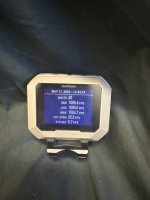
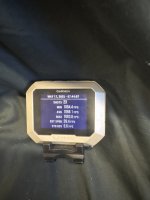
That being said, I plan on literally using my ammo selection routine to lot test but maybe I’m more selective than most. These were pretty recent with my DPG Vudoo. It’s been sub MOA at distance and at 200 literally stacked rds.
Those are my expectations, along with really seeing where any issues will come up with this new action. Mine was specifically not heat treated to see what if any wear patterns happen.


Well thiers a lot of factors involved and this seems to be an ongoing debate. Ill briefly state my findings in a semi short write up. This is still a personal opinion backed by my own testing. I also started my shooting as a paper patcher, cast lead shooting, lead swagger and competing in quigley shooting competition both in black powder and high velocity cast lead. The terms Obturation, BHN, permanent deformation, working pressure and optimal twist rates for a lead projectiles is where I've been able to link my expirence with performance in a 22lr cartridge. I'll explain the best I can below.Like
Dislike
@EagleEyeShooting what are your thoughts of barrels and lot sensitivity?
Have you found a particular barrel twist, rifling, chamber, etc is more or less sensitive to batches/lots or is there no effect?
I'm about 90% on board with longer barrel=lower SD, but as most people are doing 24+" for balance these days it's kind of a moot point.
Or are you seeing a difference between 24", 25", 26"?
First of, we have to set the fact that dedicated benchrest rest rifles that are built correctly will always outperform a repeater action. My BR rifles will always out perform my PRS rifles, taking 100 round comparison, total group sizes are nearly double with my PRS builds. I use 26in barrels for my BR rigs that have a tighter bore and cherry picked barrels that I air gauge myself, however, tend to have cold bore shift and lower velocities. In the BR world, it's common to see 24-28in barrels
Thiers a false notion that we can setup a PRS style rifle to shoot as good as a BR. When you look at how a 2500x action is designed, the 2500x is a more rigid system with mid locking lug, flat bottom, 3 action screws, extractors at 9 and 3 o clock with the firing pin at 6 for a more consistent ignition. At least for me, I can confidently say that I'm able to build a 2500x or V22s to outperform a PRS rig. Though I have a lot of clients who do well in ARA with thier repeater actions and PRS rigs
I have seen better performance with longer barrels 24-26.5" having more consistent accuracy lot to lot and not as effected in weather conditions over 22" and shorter barrels. At these longer barrels lengths, it's also more common to see cold bore shift due to the bore deflection and diameter on traditional gun drill barrels. This is why I developed my barrels to use ECM rifling to aid in minimal bore deflection at these longer barrel lengths and tighter bore diameter. If you ever have ran a boring machine to pull pipe or wire, you'll understand what im saying here, Even with high grade stainless steel, density in the metal can vary hardness, traditional gun drills will deflection higher on harder areas and dive down on softer, just like a boring machine tunneling underground. Take account we are dealing with a highly sensitive cartridge that can be influenced by many factors.
I've done a 22lr Video series show casing how much our 22lr projectiles vary in BHN. Ranging from 5.8 to 9 BHN
Lapua ammo tends to be on the softer side around 6 BHN +-0.4. Given the chart above, working pressure. The silver you see in Eley ammo is due to a higher Tin (TIN) and Antimoney (Sb) content, as a result Eley bullets are harder in BHN around 8.3-9 BHN. Hence why you see the ammo faster because higher pressure is needed to reach optimal working pressure for Obturation. Obturation refers to the process where a soft lead bullet or projectile deforms and expands under pressure to fill the bore of a firearm. if you exceed the working pressure, your projectile will permanently deform resulting in BC deviation and accuracy issues. So its a balance of your barrels bore and groove uniformity to match your lead projectile and ammo deviation in BHN and powder/primer combo. This is why I stress greatly on quality of a barrel for 22lr. The rifling in your barrels makes a difference in these factors and contribute to your BC G1, RA4 down range
As for twist rates, Im still open to understand faster twist options. I have only tested 1:18, 1:16, 1:13, 1-14 and 1-12 twist. Knowing what I learned in lead swaged projectiles, thiers impurities and imperfections in our 22lr lead projectiles that have a tendency to get out of balance at faster twist rates. Weather and DA play a factor to this also. What I consider accuracy for these rifles is the ability for the shooter to take my rifle and various lots of ammo and hold MOA or better out to 300 meters. I tend to see pickness and more flyers with faster twist barrels. Also, shooting into or behind wind, I found I fight more Aero dynamic jump when taking shots at 200+ meters. I know shops tend to push faster twist rates. But I truly believe they are mistaking the performance of barrels like Mullerworks and thier micro groove rifling producing higher G1/ RA4 BC as the faster twist rates being the factor. I've been asking for these shops along with my clients to have them produce their data. What I can show with a Oehler 89 bc chronograph is the higher BC values of certain barrels over traditional cut rifled barrels and how twist rates dont factor in deviation in BC. I also have data showing 100 rifles I built in the past with the batch of 1:13 twist Mullerworks barrels over all performance... having had to rebarrel over 30% of that batch to meet my shops accuracy standards vs the next batch at 1:16 twist with nearly half that percentage.
If you dive into looking at this factor of stability at longer distances. E.G 22lr at 100 meters at 1010 FPS will be about 56000 RPM with a 13 twist and a 1:16 is about 45000 RPM. Factor in Bryan Litz coined term of Mach Trimming, you start to see the stability factor of these 22lr is greatly influenced on the BC of the projectile at extended ranges, not so much RPM. Todd Hodnett and AB team I happened to see in person was doing test with sub sonic 308 at ELR distances and found much great accuracy with slower twist and subsonic bullets. This also was proven with 338 Lapua. I also found 1:16 and 1:18 twist barrels in my cast lead rifle days to produce better accuracy.
Now thiers the other side to this where twist rates like 1:7-1:9 might offer some break through with what we know. Again im open to understanding if anyone is willing to share. I have a Bartlein 1:9 twist .2175 bore sitting here for this expirement
Last edited:
View attachment 8701931View attachment 8701932
These knobs appear to work with the B14r also if I install the M6x1 grub screw. Anarchy unfortunately converts the thread with thier handle to a 5/16, meaning you will need a 5/16x24 knob. CZ457 and B14rs using M6x1
That's not a bolt knob.
This. This right here is a bolt knob.
Well thiers a lot of factors involved and this seems to be an ongoing debate. Ill briefly state my findings in a semi short write up. This is still a personal opinion backed by my own testing. I also started my shooting as a paper patcher, cast lead shooting, lead swagger and competing in quigley shooting competition both in black powder and high velocity cast lead. The terms Obturation, BHN, permanent deformation, working pressure and optimal twist rates for a lead projectiles is where I've been able to link my expirence with performance in a 22lr cartridge. I'll explain the best I can below.
First of, we have to set the fact that dedicated benchrest rest rifles that are built correctly will always outperform a repeater action. My BR rifles will always out perform my PRS rifles, taking 100 round comparison, total group sizes are nearly double with my PRS builds. I use 26in barrels for my BR rigs that have a tighter bore and cherry picked barrels that I air gauge myself, however, tend to have cold bore shift and lower velocities. In the BR world, it's common to see 24-28in barrels
Thiers a false notion that we can setup a PRS style rifle to shoot as good as a BR. When you look at how a 2500x action is designed, the 2500x is a more rigid system with mid locking lug, flat bottom, 3 action screws, extractors at 9 and 3 o clock with the firing pin at 6 for a more consistent ignition. At least for me, I can confidently say that I'm able to build a 2500x or V22s to outperform a PRS rig. Though I have a lot of clients who do well in ARA with thier repeater actions and PRS rigs
I have seen better performance with longer barrels 24-26.5" having more consistent accuracy lot to lot and not as effected in weather conditions over 22" and shorter barrels. At these longer barrels lengths, it's also more common to see cold bore shift due to the bore deflection and diameter on traditional gun drill barrels. This is why I developed my barrels to use ECM rifling to aid in minimal bore deflection at these longer barrel lengths and tighter bore diameter. If you ever have ran a boring machine to pull pipe or wire, you'll understand what im saying here, Even with high grade stainless steel, density in the metal can vary hardness, traditional gun drills will deflection higher on harder areas and dive down on softer, just like a boring machine tunneling underground. Take account we are dealing with a highly sensitive cartridge that can be influenced by many factors.
I've done a 22lr Video series show casing how much our 22lr projectiles vary in BHN. Ranging from 5.8 to 9 BHN
View attachment 8703056
Lapua ammo tends to be on the softer side around 6 BHN +-0.4. Given the chart above, working pressure. The silver you see in Eley ammo is due to a higher Tin (TIN) and Antimoney (Sb) content, as a result Eley bullets are harder in BHN around 8.3-9 BHN. Hence why you see the ammo faster because higher pressure is needed to reach optimal working pressure for Obturation. Obturation refers to the process where a soft lead bullet or projectile deforms and expands under pressure to fill the bore of a firearm. if you exceed the working pressure, your projectile will permanently deform resulting in BC deviation and accuracy issues. So its a balance of your barrels bore and groove uniformity to match your lead projectile and ammo deviation in BHN and powder/primer combo. This is why I stress greatly on quality of a barrel for 22lr. The rifling in your barrels makes a difference in these factors and contribute to your BC G1, RA4 down range
As for twist rates, Im still open to understand faster twist options. I have only tested 1:18, 1:16, 1:13, 1-14 and 1-12 twist. Knowing what I learned in lead swaged projectiles, thiers impurities and imperfections in our 22lr lead projectiles that have a tendency to get out of balance at faster twist rates. Weather and DA play a factor to this also. What I consider accuracy for these rifles is the ability for the shooter to take my rifle and various lots of ammo and hold MOA or better out to 300 meters. I tend to see pickness and more flyers with faster twist barrels. Also, ...
....
If you dive into looking at this factor of stability at longer distances. E.G 22lr at 100 meters at 1010 FPS will be about 56000 RPM with a 13 twist and a 1:16 is about 45000 RPM. Factor in Bryan Litz coined term of Mach Trimming, you start to see the stability factor of these 22lr is greatly influenced on the BC of the projectile at extended ranges, not so much RPM. Todd Hodnett and AB team I happened to see in person was doing test with sub sonic 308 at ELR distances and found much great accuracy with slower twist and subsonic bullets. This also was proven with 338 Lapua. I also found 1:16 and 1:18 twist barrels in my cast lead rifle days to produce better accuracy.
Now thiers the other side to this where twist rates like 1:7-1:9 might offer some break through with what we know. Again im open to understanding if anyone is willing to share. I have a Bartlein 1:9 twist .2175 bore sitting here for this expirement
Taking a historical look at short range benchrest rifles in 6 PPC, they overwhelmingly use 13.5tw and 14tw for 65-68gr bullets. It doesn't matter if they are flat based or boat tail.
The explanation for the choice is to cause the least amount of upset to the bullet, while giving it the minimal amount of spin. Most of the shooters are sending the little bullets out around 3350-3400 fps.
Doing the math, you can see they keep the spin rate to it's absolute minimum.
As pointed out above, if there's a slight defect in a projectile, it's less likely to head off in some unknown direction. It's more likely to stay within or very near group center.
There's no reason this same philosophy shouldn't apply to 22LR bullets.
To put it into a simple to understand description:
Install a set of unbalanced tires on the front of your vehicle. Using vehicle speed to represent velocity and rotation, get the vehicle up to 25 mph. You probably won't notice the balance issue.
Now, slowly increase your speed (and tire rotation rpm) to 35mph.
If the road is smooth, you might begin to notice the out of balance condition.
Now, take it up to 60mph.
There you go. You feel it.
As you continue to increase speed, not only do the tires transmit the balance issue, they begin to bounce. The only thing keeping them from going off on their own direction is the axle and lug nuts. A projectile doesn't have lug nuts or an axle, so off it goes, out of the group you just tried to shoot.
Keeping the spin rate down, prevents the bullets from hauling ass out of the group. A lower spin rate (within reason of course) keeps them on their path to the group.
None of what I wrote above accounts for atmospheric conditions like rain or wind.
If you ever have extra bolt handles let me know (especially the facet spool styles) let me know, I'd buy one or two.View attachment 8701931View attachment 8701932
These knobs appear to work with the B14r also if I install the M6x1 grub screw. Anarchy unfortunately converts the thread with thier handle to a 5/16, meaning you will need a 5/16x24 knob. CZ457 and B14rs using M6x1
Quick update………the rifle is everything I expected. It’s still an untreated bare metal action, but the modularity is impressive and the accuracy surpassed my already lofty expectations. It’s currently setup for Vudoo mags, but I think going to RimX mags are the next option, hopefully for next weekend so people can play with it.
I honestly believe it’ll surpass anything that’s currently on the market. It’s also considerably slower than any Rimfire I’ve shot to date.
I honestly believe it’ll surpass anything that’s currently on the market. It’s also considerably slower than any Rimfire I’ve shot to date.
Similar threads
- Replies
- 12
- Views
- 2K
